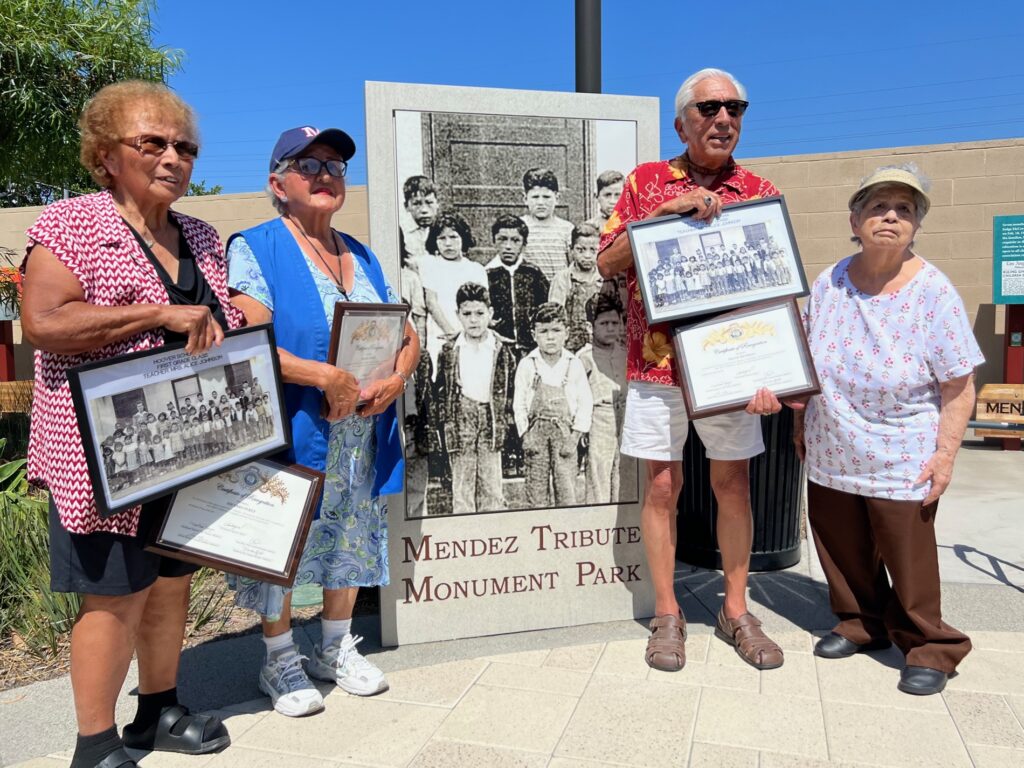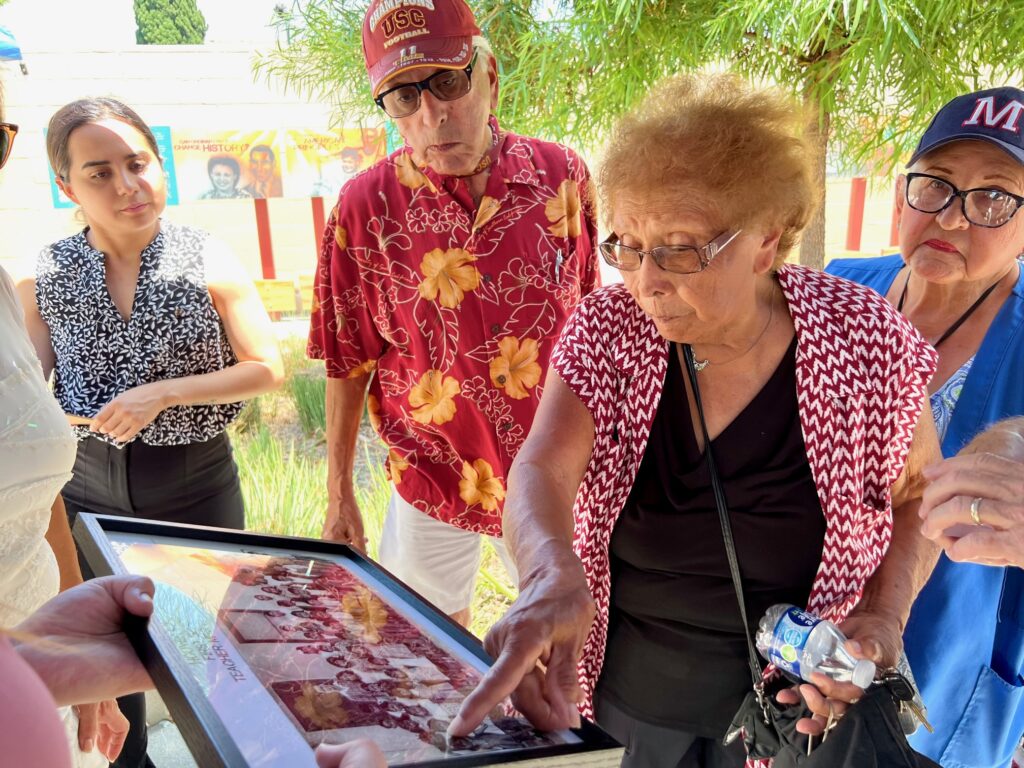
Socorro “Coco” Puebla gently traced her finger over the black and white image of 40 schoolchildren, casually recalling the names of first-grade classmates from nearly eight decades ago. Behind her stood two others whose younger faces also appeared in the class photo, as another long-ago schoolmate approached with a warm smile.
The City of Westminster commemorated a landmark civil rights court case on Tuesday with an intimate yet powerful reunion at Mendez Tribute Monument Park.
Along with Puebla — her last name was Perez when the class picture was taken — Dolores Martinez, Luisa Medina and Frank Mendoza were all students together at the school known as Hoover Elementary, which up until the 1940s was the only option for Westminster children of Mexican descent. At the invitation of city officials, the four, who are all in their 80s now, gathered for about 90 minutes to share memories of Hoover and to reflect on the legacy of the historic Mendez v. Westminster case, which in 1947 ended the forced segregation of Mexican-American students in Orange County — and paved the way for the U.S. Supreme Court’s Brown v. Board case seven years later.
During a brief question-and-answer session, each former Hoover student was asked to describe their experiences attending school before integration.

Medina spoke of her struggles to learn English, but she also remembered a kind and patient teacher named Mrs. Cook, and she talked about going home for lunch. She expressed gratitude to all who helped create Mendez Tribute Monument Park, which in 2022 became the first public space to honor the Mendez case, the families behind it, and its far-reaching impacts.
“I have fond memories, and I’m very happy that this was taken care of because I always have said the younger generations need to know what we went through and that it wasn’t easy,” said Medina, whose last name in school was Hernandez. “And not to lose sight of the people that came before us.”
Westminster City Council member Carlos Manzo organized the reception along with former council member Sergio Contreras, who is credited with spearheading efforts to open Mendez Tribute Monument Park in partnership with the Orange County Department of Education. Among the park’s features is a blown-up version of the historic photo from Hoover, showing Mrs. Alice Johnson’s first-grade class from 1944. It’s divided over two granite panels that caught the attention of the former students, most of whom are now grandparents or great grandparents.
Also in attendance Tuesday were Westminster Mayor Chi Charlie Nguyen — he presented each special guest with a certificate of recognition — representatives from OCDE, and artist Ignacio Gomez, who sculpted the statues that serve as the park’s centerpieces.
A crucial milestone
By any measure, Mendez v. Westminster represents a crucial milestone in the country’s efforts to end forced segregation in public schools. The case was brought against the Westminster School District by Gonzalo and Felicitas Mendez after the couple tried unsuccessfully to enroll their three children at Westminster’s 17th Street School in 1943.
Despite being American citizens, the family was told that 17th Street School was exclusively for White students. Their children would have to attend the less desirable Hoover Elementary campus.
Four other Mexican-American families from Orange County joined the legal fight that would follow, working with Los Angeles attorney David Marcus. He argued in federal court that segregated schools violated the 14th Amendment’s Equal Protection Clause.
In February 1946, U.S. District Court Judge Paul J. McCormick ruled in favor of the plaintiffs, declaring that policies promoting the segregation of Mexican-American students were unconstitutional. Though the case was appealed, McCormick’s ruling was upheld by the U.S. 9th Circuit Court of Appeals on April 14, 1947.
“We wanted to go to 17th Street School, but they would not let us go to 17th Street School,” said Puebla, who worked for a clothing factory and, later, a craft store after high school. “We had to stick to our own little school there. But, you know, to me, at my time, at my knowledge, I was thankful that we were going to school because our parents could not afford it.”
Looking back on his days at Hoover, Frank Mendoza said he didn’t recall substandard buildings or tattered instructional materials. And even if some of the book covers showed wear and tear, it’s what was inside them that counted, he said.
“It’s hard now at our age now to remember exactly how we felt or what we thought because we were children,” he said. “All I remember is that we were in school, and our parents were happy that we were in school because a lot of our parents had not had much education, if any, in a lot of cases. So they were happy that we were in school learning English.”
Brown v. Board precursor
The Mendez ruling is considered a precursor to the U.S. Supreme Court’s Brown v. Board of Education decision, which in 1954 declared school segregation unconstitutional across all 50 states.
While Brown v. Board is more widely known, public awareness of the Mendez case has continued to expand thanks largely to the efforts of Sylvia Mendez, who was 8 years old when her parents went to court on behalf of her and her brothers Geronimo (Jerome) and Gonzalo, Jr.
The Hoover students from the photo were in high school when Brown v. Board came down, but Puebla said she knew the ruling was coming — eventually.
“We knew that it was going to get better instead of getting worse,” she said. “We were happy for what we had, and we didn’t complain. But at the same time, it was getting better, and we were happy for our children. They were going to come along and get a better education, you know?”
As students in Orange County get ready to return from summer break, Tuesday’s reception was intended to serve as a reminder of the historical significance of Mendez v. Westminster and the importance of ensuring that every student, regardless of background, has access to a quality education.
“We are not far removed from the Mendez v. Westminster civil rights case,” Council member Manzo said. “We have come a long way, but have a long way to go.”
“We can all learn how far we have come when we remember and celebrate together,” added Contreras, the former council member. “No matter your race or background, anything is possible.”
Mendez Tribute Monument Park is located at 7371 Westminster Blvd. in Westminster. In addition to interpretative panels with details on the case, the quarter-acre park features statues of Gonzalo and Felicitas Mendez and sculpted figures of schoolchildren, representing the 5,000 students who became part of the monumental legal action. An accompanying trail is set to open in Westminster later this year.
To learn more about the park, visit www.mendezpark.org.
